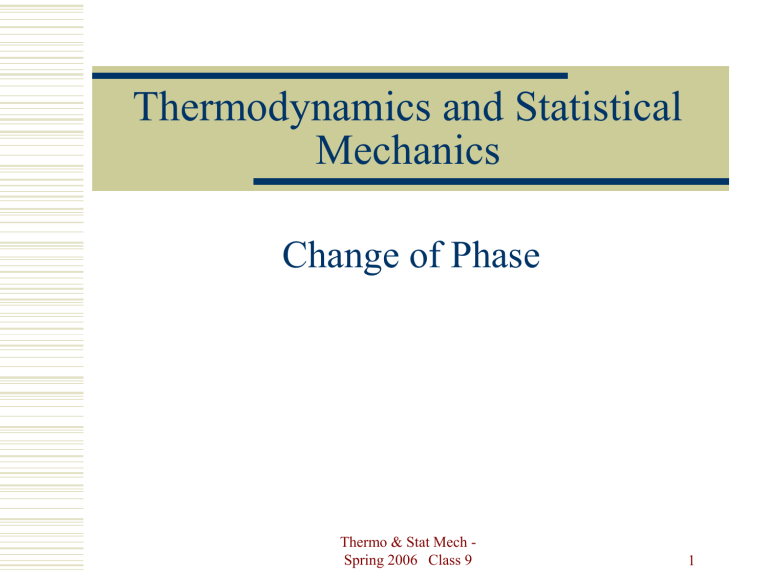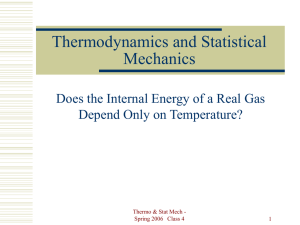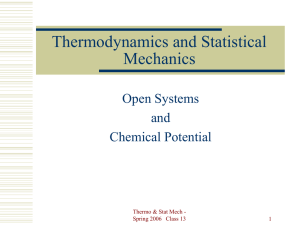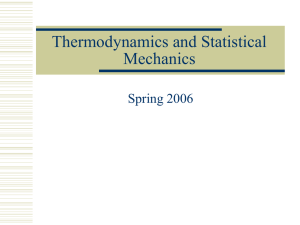Thermodynamics and Statistical Mechanics Change of Phase Thermo & Stat Mech -

Thermodynamics and Statistical
Mechanics
Change of Phase
Thermo & Stat Mech -
Spring 2006 Class 9 1
Thermodynamic Potentials
We know that for an isolated system,
D
S
≥ 0.
Therefore, any processes in an isolated system can only increase entropy, and the system will be in equilibrium when it reaches maximum entropy.
But what of a system that is not isolated?
Thermo & Stat Mech - Spring 2006
Class 9 2
Helmholtz Function
Suppose a system is in contact with a reservoir at temperature T. The system undergoes a process, and Q is transferred from reservoir to system.
D
S
0 is the entropy change of the reservoir, and
D
S is the entropy change of the system.
D
S
0
+
D
S
≥ 0
Thermo & Stat Mech - Spring 2006
Class 9 3
Work
D
S
0
Q
T
Q
W
T
D
S
D
U
so,
D
S
0
0 , or T
D
S
Q W
+
D
S
D
U
≥ 0 becomes
Q
T
D
S
W
W
( U f
( U i
U i
TS i
)
)
( TS
( U f f
TS i
)
TS f
)
F i
F f
Thermo & Stat Mech - Spring 2006
Class 9 4
Helmholtz Function
W ≤ – D
F (Constant T )
If work is zero for the process,
D F ≤
0, or F f
≤ F i
System tends to go to lowest F.
At stable equilibrium when dF = 0
Thermo & Stat Mech - Spring 2006
Class 9 5
Gibbs Function
If contact with the reservoir keeps both temperature and pressure constant, the system goes to the lowest value of the Gibbs function.
As before, T
D
S
≥
Q , but in addition, W = P
D
V.
Then, Q =
D
U + P
D
V , or
D
U + P
D
V – Q = 0
D
U + P
D
V – T
D S ≤
0
Thermo & Stat Mech - Spring 2006
Class 9 6
Gibbs Function
D
U + P
D
V – T
D S ≤
0
( U f
+ PV f
– TS f
)
–
( U i
D G ≤
0
+ PV i
– TS i
)
≤
0
G f
≤ G i
Constant T and P .
Stable equilibrium when dG = 0
Thermo & Stat Mech - Spring 2006
Class 9 7
Gibbs Function
If non-mechanical work is done by the system, at constant T and P , then as with F ,
W nm
≤ D
G
Thermo & Stat Mech - Spring 2006
Class 9 8
Phase Transition
A phase transition, as from a liquid to a vapor, usually takes place at constant temperature and pressure. Therefore the system will go to the state of lowest Gibbs function. Let us see how the specific Gibbs function changes with temperature.
g
is the vapor and g
is the liquid.
Thermo & Stat Mech - Spring 2006
Class 9 9
Gibbs Function at Transition
Thermo & Stat Mech - Spring 2006
Class 9 10
Gibbs Function dG = – SdT + VdP G ( T , P ) dG
S
G
T
G
T
P
P dT
and
G
P
T dP
V
G
P
T V
Thermo & Stat Mech - Spring 2006
Class 9 11
Transition
Thermo & Stat Mech - Spring 2006
Class 9 12
Transition n
1
G
G
1
2
n
1
n
2
n
2
n
1
g n
2
g
n
1
g n
2
g
G
1
G
2 so g
g
Thermo & Stat Mech - Spring 2006
Class 9 13
Real Substance
Thermo & Stat Mech - Spring 2006
Class 9 14
Transition g
g
( d g
s
dT d g
v
dP s
s
) dT
( v
s
dT
v
) dP v
dP dT
T ( s
s
v s
)
s v
23
Latent heat dP
Thermo & Stat Mech - Spring 2006
Class 9 15
Clausius-Clapeyron Equation dP dT
23
T ( v
23
v
)
Liquid vapor dP dT
13 dP dT
12
T ( v
13
v
)
Solid
T ( v
12
v
)
Solid
vapor
liquid
Thermo & Stat Mech - Spring 2006
Class 9 16
Enthalpy and Latent Heat du = đq – Pdv
At transition, u
2
– u
1 l l
12
= ( u
2
12
= h
2
+ Pv
– h
1
2
)
–
( u
1
= l
12
– P
+ P v
1
)
( v
2
– v
1
)
Thermo & Stat Mech - Spring 2006
Class 9 17
Enthalpy and Latent Heat
12
23
h
h
solid to liquid
h
h
liquid to
(fusion)
vapor (vaporizat ion)
13
h
h
solid to vapor (subllimat ion)
Thermo & Stat Mech - Spring 2006
Class 9 18
Thermo & Stat Mech - Spring 2006
Class 9 19
Regelation
Thermo & Stat Mech - Spring 2006
Class 9 20
Problem
Consider a sealed steel container completely filled with water at 0ºC and pressure of one atmosphere. Lower the temperature to – 1ºC.
What happens? Water starts to freeze, but tries to expand. That raises pressure, so freezing point is lowered. How much?
Thermo & Stat Mech - Spring 2006
Class 9 21
Freezing Problem dP dT
12
T ( v
12
v
) so
D
P
12
v
v
3 .
34
10
5
J/kg
9 .
05
10
5 m
3
/kg
T (
v
12
D
T v
)
T
D
T
273 K
1 K
Thermo & Stat Mech - Spring 2006
Class 9 22
Freezing Problem
D
P
P
1 .
35
10
7
Pa
1.01
10
5
Pa/atm
135 atm
134 atm
How much freezes?
Call the fraction that freezes x .
Thermo & Stat Mech - Spring 2006
Class 9 23
Freezing Problem v i
x
x v
f
v i
v
f
v v
f
f
( 1
x ) v
f v
f v
f
v i
v i
v
T
P
vdT
dT
vdP
v
P
T dP
Thermo & Stat Mech - Spring 2006
Class 9 24
Freezing Problem x
v v i
f
v v f
f
v
D
T v f
v
D
P v f
67
10
6
K
1 D
T
1 K
12
10
11
Pa
1 D
P
1 .
35
10
7
Pa v f
v f
9 .
05 v
10
3 m
3
/kg
10
5 m
3
/kg
Thermo & Stat Mech - Spring 2006
Class 9 25
Freezing Answer x = 0.017 = 1.7%
Not much!
Thermo & Stat Mech - Spring 2006
Class 9 26


